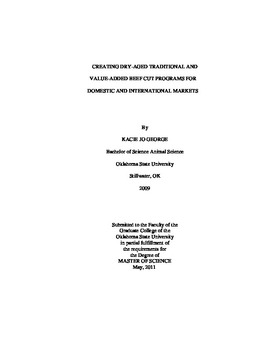| dc.description.abstract | The present study was conducted to develop a dry aging program that would maximize flavor and shelf-life along with ensuring the safety characteristics of traditional and the value cuts destined for domestic and international consumers. Beef ribeye rolls (n = 24), short ribs (n = 96), short loins (n = 48), and top sirloin butts (n = 60) were randomly assigned to one of four aging protocols. These subprimals (n = 228) were randomly assigned to one of three treatments, frozen, wet- or dry- aging, and to one of three periods, 0, 14 or 28 d. Aging protocol 1 was wet-aged for 14 or 28 d and dry-aged for 0, 14, or 28 d. Aging protocol 2 was wet-aged for 14 or 28 d, dry-aged for 0, 14, or 28 d, fabricated into steaks, vacuum packaged and wet-aged for an additional 14 or 28 d. Aging protocol 3 was wet aged for 14 or 28 d, dry-aged for 0, 14, or 28 d, fabricated into steaks, vacuum packaged and frozen for 14 or 28 d. Aging protocol 4 was frozen for 14 or 28 d and dry aged for 0, 14, or 28 d. Sensory, Warner-Bratzler shear (WBS) force evaluation, and proximate analysis (PROX) were conducted to determine characteristics. Aging protocols (AP) 1, 3 and 4 were found to be superior (P < 0.01) in terms of improving the flavor of coulotte steaks when compared to their AP 2 counterparts. Aging protocols 1 and 3 were found to be superior (P < 0.01) for improving the flavor of beef steaks from the shortloin when compared to AP 2. Consumers preferred the flavor of 28 d dry-aged boneless short rib steaks over the 0 d dry-aged steak (P < 0.02). The effect of aging period on WBS values of retail beef cuts was not significant (P > 0.05). Moisture loss percentages displayed a significant (P < 0.01) difference with the coulotte having the highest percentage moisture followed by export ribs, while short ribs boneless contained the lowest amount. Aging protocols proved to have considerable effect on consumer evaluation of various palatability characteristics for beef steaks, especially those steaks from the coulotte, export rib and shortloins. Consumers could not detect any sensory characteristics differences between AP for the sirloin, bone-in and boneless short ribs. Dry-aging periods of 14 to 28 d have appeared to be effective in producing the desired results of this process, but there does not appear to be a magical threshold where sufficient time is required beyond 14 d to truly call this beef "dry-aged" from a performance standpoint. | |
